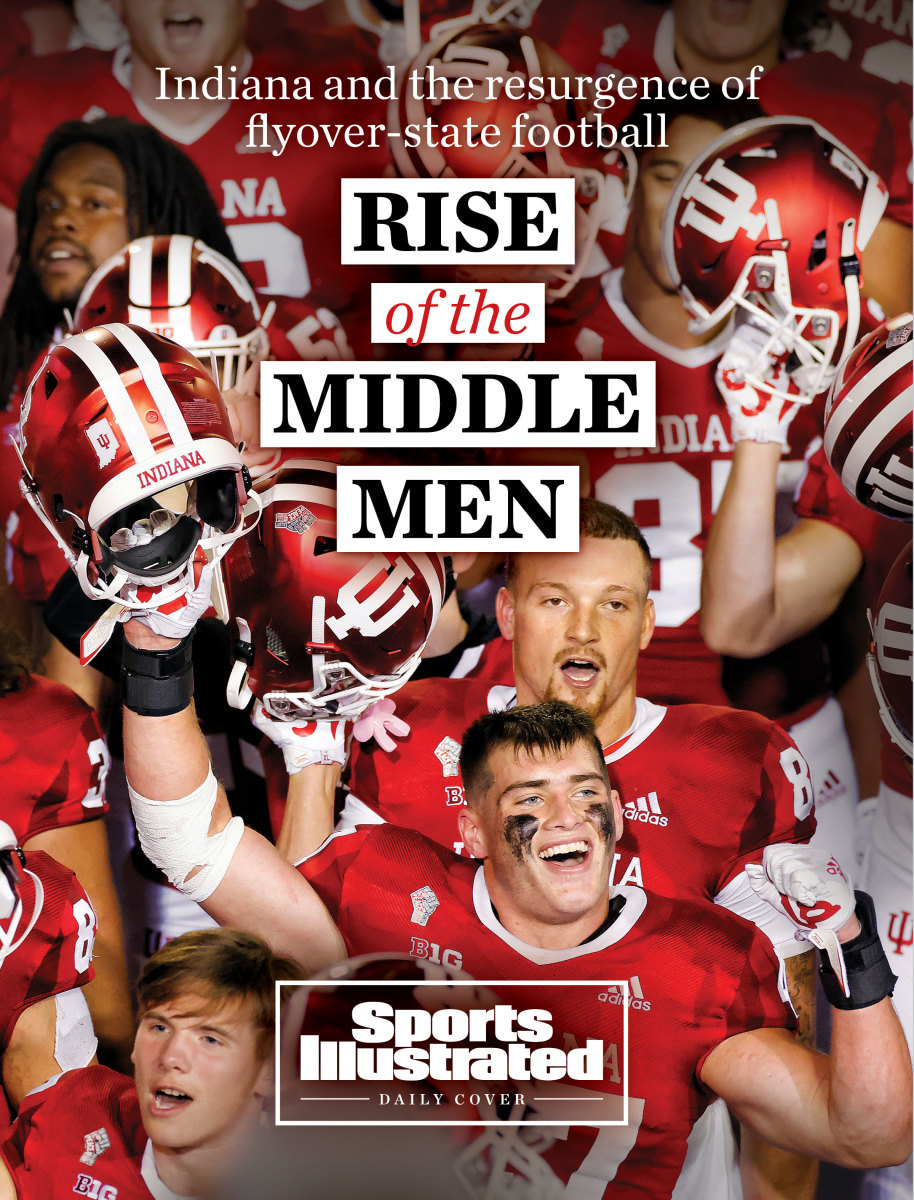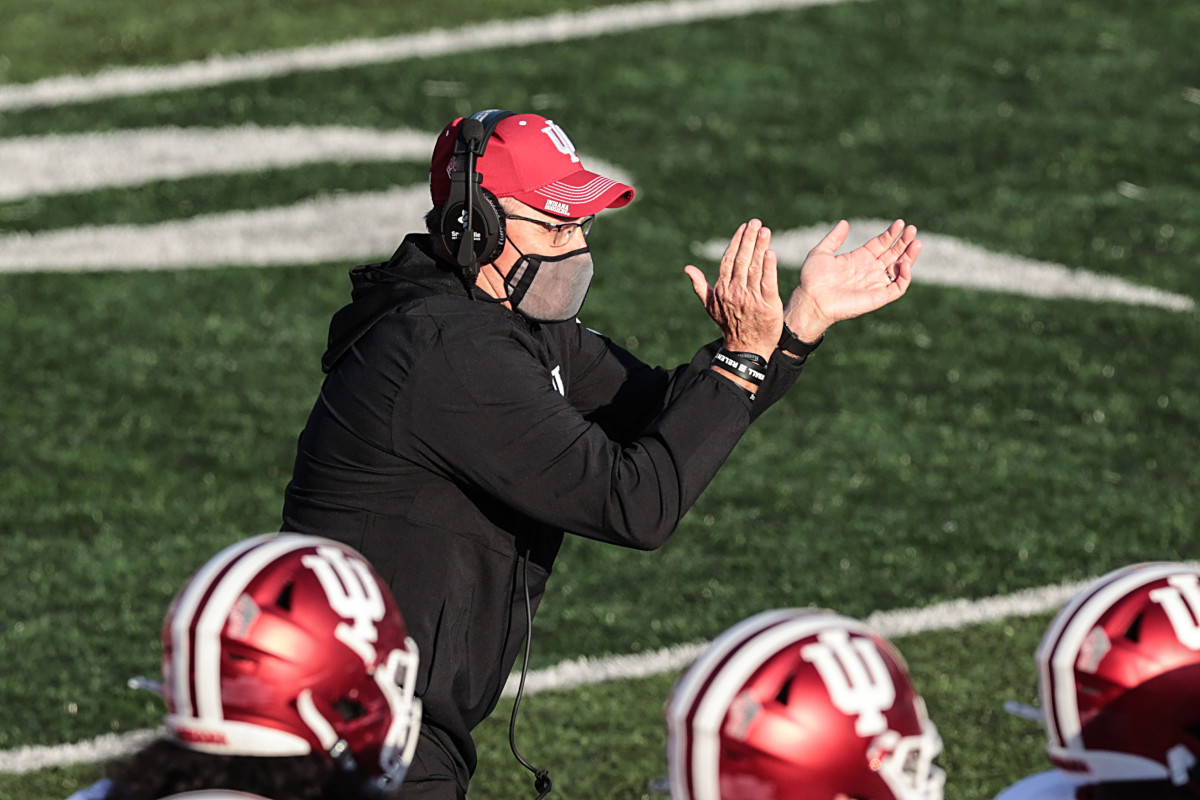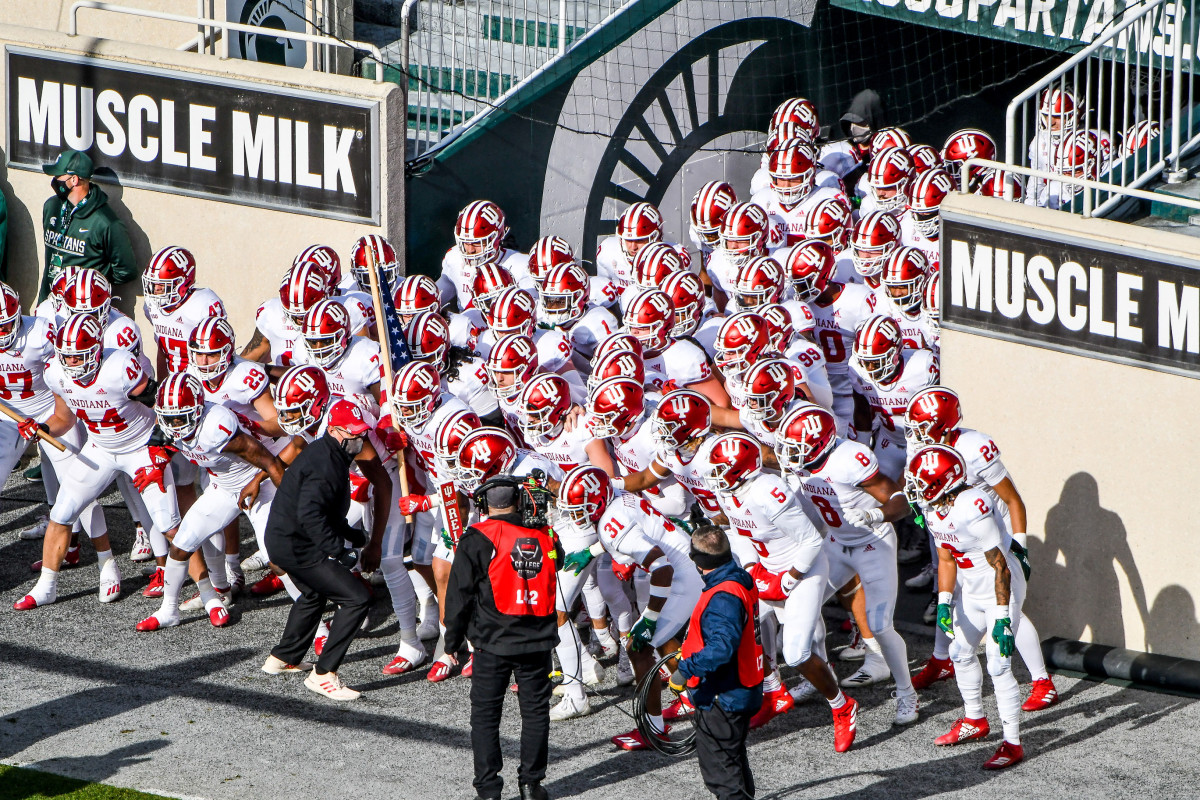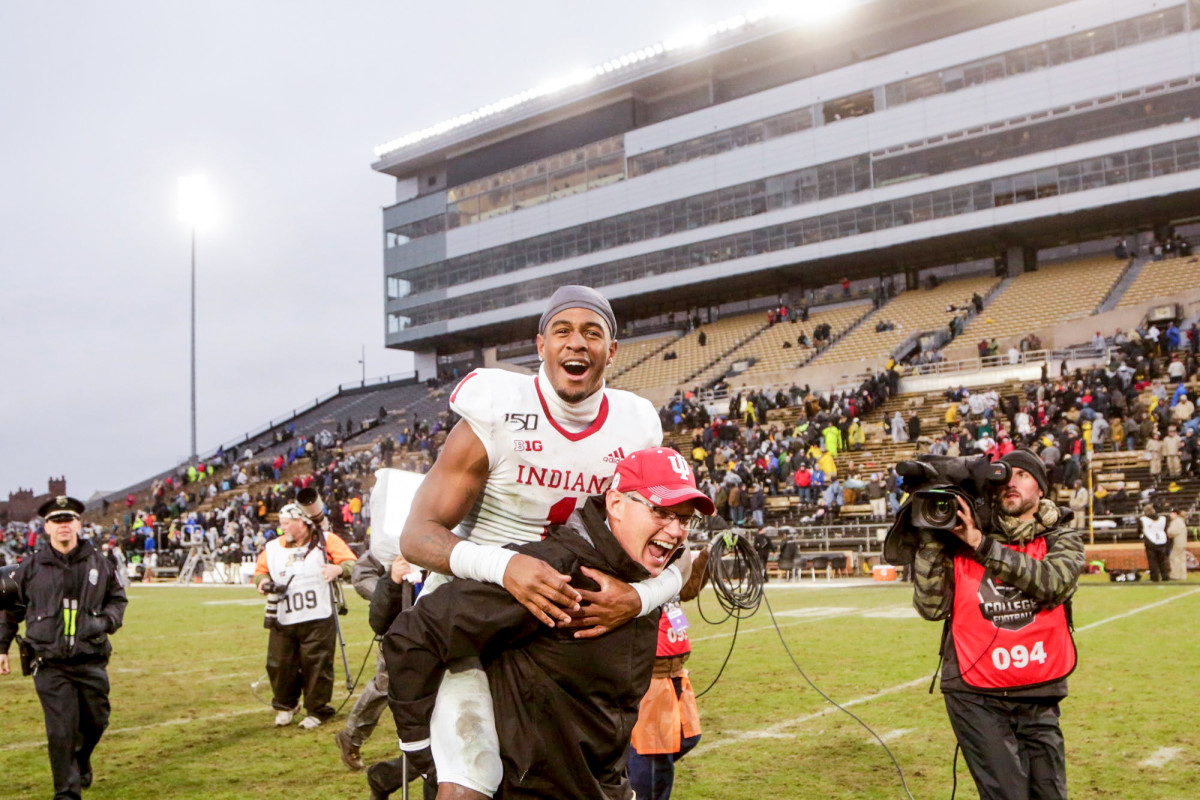Midwestern Revival Tour: Indiana
In such a bizarre season, it’s only fitting that the center of college football in 2020 is found in America’s heartland. And so Sports Illustrated’s two college football writers set out on a (masked and socially distanced) journey to the six campuses in this Midwestern footprint. Ross Dellenger has the northern tier, trekking West to East from Evanston to South Bend to Columbus. Pat Forde is taking the southern route and going East to West, from Huntington to Cincinnati to Bloomington.
We’re rolling out two stories a day, starting Wednesday and running through Friday, as well as updates on our social media platforms, using the hashtag #MidwesternRevivalTour. Keep up to date with the entire series here.
MORE: MARSHALL | NORTHWESTERN | CINCINNATI | NOTRE DAME | OHIO STATE
***
Indiana
WHY WE'RE HERE: Indiana is 4–0 and ranked No. 9 in the country, its highest ranking since 1967.
SEASON HIGH POINT: Beating Penn State in the opener on a lunging two-point conversion by quarterback Michael Penix Jr. on the final play of overtime.
PROGRAM ARC: Pretty close to a flat line for most of eternity. Indiana won eight games last year, its most since 1993, setting the stage for this breakthrough season.
PROGRAM EDGE: Indiana has recruited well at quarterback and receiver, but also is playing some of its best defense of the 21st century.
ACADEMIC BRAGGING POINT: The Kelley School of Business is ranked No. 1 nationally in online MBA programs and is among the top 25 nationally in undergraduate business schools.
CAMPUS ICONOGRAPHY: The Little 500 bike race each spring is billed as "The World's Greatest College Weekend."
PLACE YOU MUST VISIT: Nick's English Hut is old school enough that you could picture Kent Benson and Scott May sliding across the greasy floor and sharing a pitcher in one of the booths.
***

BLOOMINGTON, Ind. — A package arrived at Fred Glass’s home in Indianapolis in late October. Inside was a signed football.
“Fred,” the inscription read, “Thank you for believing in me.” The ball was stamped with this score: Indiana 36, Penn State 35. The sender was IU football coach Tom Allen.
It took a Glass half-full view of Allen to solve the decades-old riddle of a glass half-empty football program. The December 2016 decision by the former Indiana athletic director to promote an anonymous defensive coordinator after the head coach abruptly resigned under pressure was mocked throughout college football. There goes Indiana not caring about football again. One national writer suggested that Glass’s idea of a coaching search was bumping into Allen at the coffee maker in the break room and offering him the job.
Indiana was then, and is today, the losing-est program in the history of the sport. Per the schools' official numbers, the Hoosiers have lost 683 games, nearly 200 more than they have won, eight more defeats than America’s No. 2 loser, Northwestern. To those on the outside, hiring Tom Allen sure didn’t look like the master stroke that was going to change anything.
Yet here we are on a sun-splashed Thursday in this idyllic college town, anticipating a noon EST Saturday kickoff between undefeated No. 3 Ohio State and undefeated, No. 9 Indiana. The first part of that matchup is business as usual; the second part is business so unusual it seems nearly impossible. Much of the credit for this goes to the 50-year-old Allen, a Labrador retriever of a coach in terms of energy and affection for his players, a man too excitable to even care how hard the Indiana job is supposed to be.
It’s late November and they’re talking football at Nick’s English Hut on Kirkwood Ave. They’re talking football at BuffaLouie’s on Indiana Ave. Basketball, for once, can wait.
“It’s been a while since I’ve seen this much enthusiasm,” says Pete Mikolaitis, general manager at Nick’s, where upstairs in the Hoosier Room they have a signed, framed “Buckeye Busters” poster from the last time Indiana beat Ohio State … in 1987.
“I know there’s a lot of doubters out there,” says Ed Schwartzman, owner of BuffaLouie’s, the kind of place that has every inch of wall space covered in Indiana sports memorabilia. “We’re 4–0 and we’re not beating Ball State, Sisters of the Poor and Evansville. We’re 4–0 in the Big Ten. We’ll see on Saturday.”

What we’ll see is an attempt to take the next step up the tall ladder for Indiana and for Allen, who was the coach at Indianapolis Ben Davis High School just a decade before he became a head coach in the Big Ten. He wasn’t even an FBS assistant until 2011, and didn’t get his first Power 5 assistant job until 2012.
Allen wasn’t a Nick Saban assistant or an Urban Meyer disciple, the tried-and-true routes to head-coaching jobs. He worked for Hugh Freeze in those days—first at NAIA school Lambuth in Jackson, Tenn., then at Arkansas State and Mississippi. In 2015 he moved to South Florida to work under Willie Taggart. After that season, Kevin Wilson offered him the defensive coordinator job back home in Indiana.
Glass remembers spending 40 minutes pacing around his dining room table on the phone with Allen, selling him on Indiana. That was his first impression of the guy, and it was a favorable one.
Allen was a native Hoosier who played for his dad (also named Tom) at New Castle High School—the alma mater of Steve Alford, among others. He played linebacker the way he coaches, like a bottle rocket with the stem pulled off, blasting off in any random direction. “I would have been called for targeting quite a bit,” he says, if the rule had existed when he played.
Allen went on to play at Maranatha Baptist, where he also wrestled—weighing in at 215 pounds during football season and then cutting weight to wrestle at 190. He tried studying accounting for a year, but it felt wrong. He knew where he belonged. “I feel I was created to be a coach,” he says.
A high school coach, most likely. Maybe a college assistant. If he dared to dream, a defensive coordinator in the Big Ten—when he got to Indiana, Allen figured he’d reached his pinnacle. “I wasn’t thinking about being a head coach,” he says.
But Glass watched Allen work on Wilson’s staff for a year and loved everything he saw—fire, passion, scheme, and an innate ability to connect with players. “I just saw him as a leader,” Glass says. He told his assistant AD, Scott Dolson (who has now succeeded Glass after his retirement in the spring), that if Wilson ever left, Allen was the best man for the job.
Then reports of player dissatisfaction under Wilson began to surface—mistreatment of injured players, and other troubling issues. Wilson has consistently denied any element of player abuse, and he chalked up his resignation in December 2016 to “philosophical differences.” (He’s now the offensive coordinator at Ohio State, and will be trying to light up Allen’s defense Saturday.)
When that resignation came, Glass didn’t hesitate. He named Allen to coach not only Indiana’s bowl game, but to be the full-time head coach. “I had a good idea what kind of people would be interested in our job, and I thought Tom would be better than all of them,” Glass says. “A national search might have covered my ass, but I said, ‘No, he’s my guy. And we’ll not miss a beat.’ “

Fact is, Indiana had been making incremental improvement to that point. The Hoosiers made it to 6–6 and earned their first bowl bid in eight years in 2015, and backed it up with another one in ’16. Glass had raised funds and dumped it into facilities, enhancing both ends of Memorial Stadium and building what was the nation’s largest football weight room. He increased the salary pool for assistant coaches, too.
“This is overnight success 10 years in the making,” Glass says. “There’s no silver bullet to fixing it. The way Indiana football could become excellent was constant investment over time and continuity of leadership. Tom gave us that continuity.”
Still, this was a fraught situation. Allen was stepping over his ousted boss, and a lot of the players were shocked at the change. When he stood up to address the team after being hired, support came from an unlikely source—wide receiver Mitchell Paige, who hadn’t been coached by Allen, but saw the right man for the job.
“Fellas, this is tough,” Paige told the team. “But I wouldn’t want anyone else to lead us.”
Everyone in the room erupted. And Tom Allen began to cry.
He took the same emotional effervescence to the fans, and they responded. Mikolaitis remembers hearing him speak not long after he got the head job and thinking, “I’m ready to suit up for this guy.” Schwartzman, whose chicken wings are popular with both Allen and dozens of his players, has gotten to know him well over the years.
“He deserves everything he gets, and then some,” Schwartzman says. “He’s the real deal. When he’s talking to you, he’s talking to you. Nice guys finish last? Not this guy."
The emotions are never far beneath the surface for Allen, among the most animated coaches in college football. That has led to some memorable celebration injuries throughout his career, since his version of hugging a player is closer to a head-on collision.
He got a black eye in his Ben Davis days jumping on a player who made an interception. He knocked out his two front teeth diving on a celebrating pile while at Ole Miss. Less than two weeks ago, he gashed his cheek leaping into cornerback Devon Matthews after an interception against Michigan (the first time the Hoosiers have beaten the Wolverines since 1987).

After victories, he’s been known to crowd surf on his players, diving into them and trusting that they’ll catch him. They always do. He has their back; they have his front when it’s flying toward them.
The naturally hyper Allen starts his day with a few minutes of quiet reflection, then he leaps into action by ripping through 3 miles on the elliptical. “I’m a high-energy guy,” he says. “That’s how I get my nervous energy out. And besides, I’ve got to be in shape to coach the way I coach.”
Early Saturday morning, Allen will get in his workout at the team hotel in Columbus. Then it’s off to the Horseshoe, one of the cathedrals of the sport, fortunately (for Indiana) not filled with more than 100,000 fans wishing them ill will. With first place in the Big Ten East on the line, it will be time for the biggest game he’s coached. “It might hit me when we walk in there,” Allen says.
In Indy, Fred Glass will hook up the TV he bought at an early Black Friday sale on his back porch and invite over a few friends to watch outdoors, socially distanced. The guy he took a chance on—and was ripped for taking that chance—has an opportunity to watch him try to score Indiana’s biggest football victory since the 1967 team went to the Rose Bowl.
Glass remembers that team—he was an eight-year-old fan, pretending in the backyard to be receiver Jade Butcher while a buddy pretended to be quarterback Harry Gonso and threw him passes. The high points in Indiana football are painfully few and far between, but the fans are living in one of them now.
“What Tom is doing is not just being appreciated in Hoosier Nation, but in Nation Nation,” Glass says. “He has the special sauce.”
MORE: MARSHALL | NORTHWESTERN | CINCINNATI | NOTRE DAME | OHIO STATE
